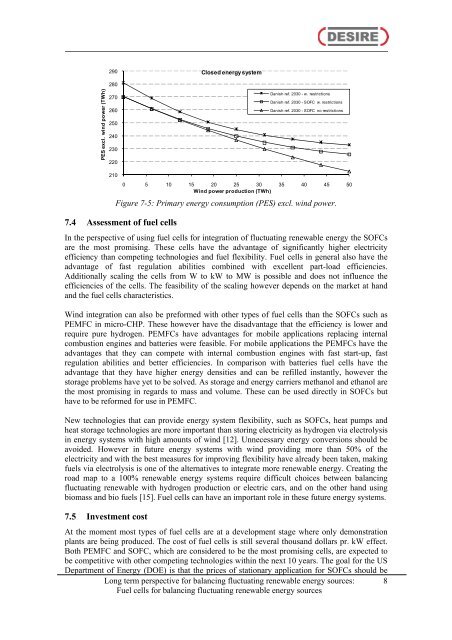Fuel cells and electrolysers in future energy systems - VBN
Fuel cells and electrolysers in future energy systems - VBN
Fuel cells and electrolysers in future energy systems - VBN
Create successful ePaper yourself
Turn your PDF publications into a flip-book with our unique Google optimized e-Paper software.
PES excl. w<strong>in</strong>d power (TWh)<br />
290<br />
280<br />
270<br />
260<br />
250<br />
240<br />
230<br />
220<br />
210<br />
Closed <strong>energy</strong> system<br />
Danish ref. 2030 - w. restrictions<br />
Danish ref. 2030 - SOFC w. restrictions<br />
Danish ref. 2030 - SOFC no restrictions<br />
0 5 10 15 20 25 30 35 40 45 50<br />
W<strong>in</strong>d power production (TWh)<br />
Figure 7-5: Primary <strong>energy</strong> consumption (PES) excl. w<strong>in</strong>d power.<br />
7.4 Assessment of fuel <strong>cells</strong><br />
In the perspective of us<strong>in</strong>g fuel <strong>cells</strong> for <strong>in</strong>tegration of fluctuat<strong>in</strong>g renewable <strong>energy</strong> the SOFCs<br />
are the most promis<strong>in</strong>g. These <strong>cells</strong> have the advantage of significantly higher electricity<br />
efficiency than compet<strong>in</strong>g technologies <strong>and</strong> fuel flexibility. <strong>Fuel</strong> <strong>cells</strong> <strong>in</strong> general also have the<br />
advantage of fast regulation abilities comb<strong>in</strong>ed with excellent part-load efficiencies.<br />
Additionally scal<strong>in</strong>g the <strong>cells</strong> from W to kW to MW is possible <strong>and</strong> does not <strong>in</strong>fluence the<br />
efficiencies of the <strong>cells</strong>. The feasibility of the scal<strong>in</strong>g however depends on the market at h<strong>and</strong><br />
<strong>and</strong> the fuel <strong>cells</strong> characteristics.<br />
W<strong>in</strong>d <strong>in</strong>tegration can also be preformed with other types of fuel <strong>cells</strong> than the SOFCs such as<br />
PEMFC <strong>in</strong> micro-CHP. These however have the disadvantage that the efficiency is lower <strong>and</strong><br />
require pure hydrogen. PEMFCs have advantages for mobile applications replac<strong>in</strong>g <strong>in</strong>ternal<br />
combustion eng<strong>in</strong>es <strong>and</strong> batteries were feasible. For mobile applications the PEMFCs have the<br />
advantages that they can compete with <strong>in</strong>ternal combustion eng<strong>in</strong>es with fast start-up, fast<br />
regulation abilities <strong>and</strong> better efficiencies. In comparison with batteries fuel <strong>cells</strong> have the<br />
advantage that they have higher <strong>energy</strong> densities <strong>and</strong> can be refilled <strong>in</strong>stantly, however the<br />
storage problems have yet to be solved. As storage <strong>and</strong> <strong>energy</strong> carriers methanol <strong>and</strong> ethanol are<br />
the most promis<strong>in</strong>g <strong>in</strong> regards to mass <strong>and</strong> volume. These can be used directly <strong>in</strong> SOFCs but<br />
have to be reformed for use <strong>in</strong> PEMFC.<br />
New technologies that can provide <strong>energy</strong> system flexibility, such as SOFCs, heat pumps <strong>and</strong><br />
heat storage technologies are more important than stor<strong>in</strong>g electricity as hydrogen via electrolysis<br />
<strong>in</strong> <strong>energy</strong> <strong>systems</strong> with high amounts of w<strong>in</strong>d [12]. Unnecessary <strong>energy</strong> conversions should be<br />
avoided. However <strong>in</strong> <strong>future</strong> <strong>energy</strong> <strong>systems</strong> with w<strong>in</strong>d provid<strong>in</strong>g more than 50% of the<br />
electricity <strong>and</strong> with the best measures for improv<strong>in</strong>g flexibility have already been taken, mak<strong>in</strong>g<br />
fuels via electrolysis is one of the alternatives to <strong>in</strong>tegrate more renewable <strong>energy</strong>. Creat<strong>in</strong>g the<br />
road map to a 100% renewable <strong>energy</strong> <strong>systems</strong> require difficult choices between balanc<strong>in</strong>g<br />
fluctuat<strong>in</strong>g renewable with hydrogen production or electric cars, <strong>and</strong> on the other h<strong>and</strong> us<strong>in</strong>g<br />
biomass <strong>and</strong> bio fuels [15]. <strong>Fuel</strong> <strong>cells</strong> can have an important role <strong>in</strong> these <strong>future</strong> <strong>energy</strong> <strong>systems</strong>.<br />
7.5 Investment cost<br />
At the moment most types of fuel <strong>cells</strong> are at a development stage where only demonstration<br />
plants are be<strong>in</strong>g produced. The cost of fuel <strong>cells</strong> is still several thous<strong>and</strong> dollars pr. kW effect.<br />
Both PEMFC <strong>and</strong> SOFC, which are considered to be the most promis<strong>in</strong>g <strong>cells</strong>, are expected to<br />
be competitive with other compet<strong>in</strong>g technologies with<strong>in</strong> the next 10 years. The goal for the US<br />
Department of Energy (DOE) is that the prices of stationary application for SOFCs should be<br />
Long term perspective for balanc<strong>in</strong>g fluctuat<strong>in</strong>g renewable <strong>energy</strong> sources: 8<br />
<strong>Fuel</strong> <strong>cells</strong> for balanc<strong>in</strong>g fluctuat<strong>in</strong>g renewable <strong>energy</strong> sources

















